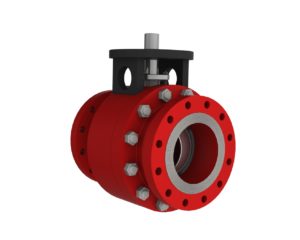When purchasing a high performance ball valve, it’s important to know what port size you need for your application. The most common types are standard port and full port. These can affect the performance and wear of your valves. Learn the differences and which one is best for your operations.
What is Port Size for a High Performance Ball Valve?

If you’re in the market for a metal seated ball valve, you likely know how they work. However, just in case, let’s quickly go over how a ball valve controls flow. Inside the valve is a ball which you can rotate with the handle. There’s a hole that goes through the ball that lines up with the connections. This allows gases or fluids to flow through the valve. For shut off, you simply rotate the ball 90° so that the hole is perpendicular to the pipe.
Now, valve port size, also called bore size, is essentially how big that hole in the ball is. Obviously this can be practically any size you want, but most of the time you’re going to see either standard port or full port in a high performance ball valve unless you customize them to your applications.
Full port means that the bore size is about the same as the pipe you’ll connect the valve to. Standard is usually one nominal pipe size below that.
So, for example, let’s say you need a forged ball valve for a ¾” pipe. If you need a full port valve, then the hole will be about ¾” in diameter. A standard port ball valve would be about ½” in diameter.
Do I Need Full Port or Standard Port Metal Seated Ball Valve?
The type of valve port you choose depends on your applications. While standard port is fine for most applications, there are some benefits of choosing a full port option. Port size will affect the valve’s flow coefficient. Full port valves have lower flow coefficient, meaning it’s pretty close to flow in a straight pipe. A standard port high performance ball valve will provide more resistance.

While full port ball valves tend to be more expensive, there are some reasons why you may need this option over a standard port. The flow resistance and pressure drop in a standard port valve can starve the system of fluid by reducing flow, may lead to more cavitation and valve wear, and can quickly cause separation between solids and fluids that can block the valve. If your application includes slurry or cavitation and turbulence are a concern, then it’s best to choose a full port valve. Otherwise, standard port can help save space and money.
Here are some industries that may need full port ball valves:
- Petrochemical
- Oil refining
- Mining
- Pulp and paper
Need Ball Valves? We Design, Manufacture, Coat, and Repair Severe Service Valves
When you need heavy-duty, high performance valves, trust Copeland Valve & Coating Technologies for all your needs. We design and manufacture metal seated ball valves optimized for your application. As the leader in severe service ball valves, our team offers the advantage of years of engineering experience and proprietary coating technologies to help your valves last. Improve safety and have peace of mind in a zero leak seal when you choose our valves. Call us today at (713) 926-7481 to request a quote for your valve design, production, coating, or repair needs.
